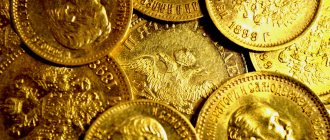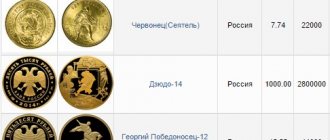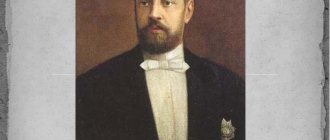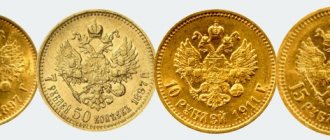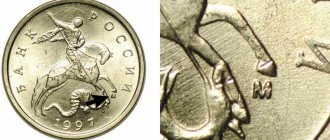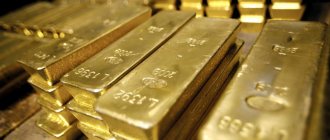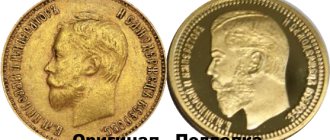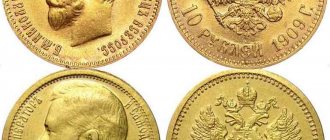The last Russian Emperor Nicholas II left behind a huge country with millions of inhabitants holding various examples of coins from the imperial era. Soon all these coins will lead to depreciation in trade and market transactions. They are being replaced by new ones - Soviet ones. For numismatists, many silver coins of Nicholas 2 have been of great interest for a whole century. This material will tell you the most interesting samples and the current cost of their variants.
Varieties and evaluation of ruble coins
All coins issued under Emperor Nicholas II dated from 1895-1917. Most of the coins were kopecks, and the highest denomination was the Nikolaev silver ruble. The production of ruble monetary units was carried out only using 900 silver.
Throughout the entire period of the sovereign's reign, only minor changes were visible in the depiction of the emperor's portrait. Having succeeded his father, Alexander III, on the throne, the parameters of the portrait were preserved, only the turn changed, moving to the west (Alexander 3 looked east). Nicholas 2 issued 1 ruble from the beginning of his reign until 1915. Outwardly, it was not fundamentally different, it was the same, for example, as the ruble of 1898 or the ruble of 1899.
Although the denomination coins are similar in many respects, there are still some features. Here, for example, is the very first ruble coin of 1985:
- reverse - an image of a double-headed eagle (symbol of the empire), with a scepter in the right paw and an orb in the left. Under the relief eagle is the denomination of the currency and the year of issue;
- obverse - a portrait of Nicholas II throughout the center, on the left along the circumference the inscription “B. M. NICHOLAY II”, on the right - “AND THE AUTODER OF ALL RUSSIA”;
- product weight - 20 grams;
- diametrical size - 33.65 mm;
- circulation amounted to about 1.1 million products;
- the side surface - “pure silver 4 spools 21 lobes” and the author’s initials “A.G.”, items with a smooth edge were less common.
The 1896 ruble already has a greater number of varieties due to the expansion of the minting area by the Paris Mint and the Brussels Mint. The maximum ruble coin of this year is similar to the ruble of 1898 in that they have a 180-degree alignment, which is not observed in the others. Here are the differences between the side inscriptions of the ruble:
- smooth edge;
- with two stars instead of the inscription (Brussels Mint);
- standard inscription as on the 1895 example.
Its circulation amounted to more than 10 million copies. This year was distinguished by the original issue of a special type - the 1896 “Coronation” ruble, on the reverse of which there is no image of an eagle, but only a scepter crossed with an orb.
The silver ruble of 1898, with the same parameters, adds another appearance, where instead of an inscription on the edge there is one star.
The 1899 ruble begins to be supplemented by other initials printed on the side of the product - E B or F Z. This happened due to a change in stamps at the St. Petersburg Mint. Similar to previous monetary units, occasionally the ruble of 1899 was mistakenly minted with a smooth edge.
Table of comparative assessment of ruble coins in good preservation:
| Product type | Ruble 1895 | Ruble 1898 | Ruble 1899 |
| Price | 10 400 | 3 200 | 4 100 |
Nicholas 2 penny coin products Thus, the price of the product depends not only on the type of coin, but also on the circulation. The ruble of 1899 and the previous one were minted in much larger quantities, so the price tag is lower. In any case, any well-preserved silver ruble of Nicholas II represents excellent value at auction among both amateurs and professionals.
The kopecks issued under the emperor were divided into 3 categories:
- Billon - the base of the coin alloy consisted of 500 silver, such products had the following denominations:
- 5 kopecks;
- 10 kopecks;
- 15 kopecks;
- 20 kopecks.
- Silver - 25 and 50 kopeck monetary units were made from the highest standard of silver (900).
- Copper - the smallest monetary items were made of copper alloy: 1, 2, 3-kopeck coins.
The images of coins in denominations of 50 and 25 kopecks were identical to the ruble copies, repeating the portrait of the autocrat on the obverse and the coat of arms on the reverse.
Many coins stopped being issued in 1915, but, for example, the half-fifty coin was minted from 1895 to 1901. The price of coins issued during the last year of minting reaches 200 thousand rubles per piece due to the limited circulation, with a cost of only 150 rubles.
Small change copper coins had a massive circulation; outwardly, they had a distinct coat of arms of the empire on the reverse, but on ½ and ¼ and 1-kopeck coins, the reverse side was decorated with the signature monogram of Nicholas II. On the 2-kopeck coin in silver, the monogram replaces the coat of arms.
You can find out how much a certain penny monetary unit is worth at numerous online auctions. 900 silver coins are much easier to sell, even considering the cost. The price tag of such products is ten times, sometimes even a hundred times higher than the cost of copper or 500 standard samples.
Here is a comparative table of the cost of different-sized monetary units depending on the denomination of 1901:
| Denomination (kop.) | 5 | 10 | 15 | 20 | 25 | 50 |
| Price, rub.) | 580 | 290 | 546 | 279 | 790 000 | 5 600 |
Comparative table of penny products 1917: The final year of imperial power was marked by difficult times, the minting of coins was suspended. Only a few samples came out of the mint: 10, 15, 20-kopeck pieces. Naturally, the price category of such coins is very high. Coins issued from 1915 to 1917 distinguished by the absence of mint initials and the small form of issue due to the First World War.
| Denomination (kop.) | 10 | 15 | 20 |
| Price | 12 980 | 13 500 | 81 230 |
Tsar's ruble
On the reverse side is an image of the Small Coat of Arms of the Russian Empire with a double-headed eagle (drawing by Fadeev, imperially approved on December 8, 1856). In the eagle's paws are a scepter and an orb. On two heads of the eagle there is a crown. The third crown crowns the first two. On the chest there is a shield with the image of the horseman of St. George the Victorious slaying the serpent. Eight small shields were placed on the fluffy wings of the eagle. On the right wing there are shields with the coats of arms of Poland, Kazan, Chersonese Tauride and the combined coat of arms of the Kyiv, Vladimir and Novgorod great principalities. On the left wing there are shields with the coats of arms of Astrakhan, Siberia, Georgia, Finland. Below, under the coat of arms, there is a denomination (“RUBLE” or “50 KOPEEK”) and the year of issue (for example, “1903”) and a curly star between the inscriptions. Along the edge of the coin (on the stamp and obverse sides) there is a patterned, slightly protruding edging, due to which, when palpated, the coin seems slightly depressed in the stamp part.
On the edge of the ruble along the entire circumference there is the inscription: “PURE SILVER 4 GOLD 21 LOVES” and the sign (F•Z), but there are signs (A•P), (E•B), (B•C) or just an asterisk (one * or two **). On the edge of the fifty-kopeck piece there is the inscription: “PURE SILVER 2 GOLD 10.5 LOVES,” followed by a sign or an asterisk. The signs “F.Z”, “A.R”, “E.B” and “V.S” are the signs of mintsmeisters (officials responsible for issuing coins) [ see
.].
Weight 1 ruble
was 20 g (Ag 900) and it was produced from 1895 (more precisely, from 1886 with these geometric and physical parameters - even by Alexander III) to 1915.
In 1915, the last issue of the silver ruble was produced in a meager circulation. Fifty kopecks
weighing 10 g (Ag 900) were issued from 1895 (1886) to 1914 Nikolaev silver
25 kopecks
(5 g, Ag 900) were minted until 1901,
20 kopecks
(3.6 g, Ag 500),
15 kopecks
(2.7 g, Ag 500) and
10 kopecks
(1.8 g, Ag 500) - until 1917, and
5 kopecks
(0.9 g, Ag 500) - until 1915.
The circulation of rubles and fifty kopecks of Nicholas II varied greatly over the years. The largest circulations were at the end of the 19th century, in 1896-1898 - about 44-46 million pieces, the smallest - in the early 1900s. In 1903-1906 and 1913, only 12-55 thousand pieces of 1 ruble coins were produced per year. As a result, prices today for these coins (depending on the year) also vary sharply. The average price of fifty kopecks and rubles from the end of the year before last (nineteenth) century at online auctions averages 900-3000 rubles. And, for example, the price of 50 kopecks in 1908 reaches 1000 USD or more. The price of 1 ruble in 1903-1906 and 1913 is 30-50 thousand rubles and sometimes reaches 100-150 thousand rubles or more (1904 - 20.817 USD). And here another factor comes first: the condition of the coin. If the safety of the coin is good VF (or very good EF), then its price, with other equal parameters (for example, the same year of minting) can increase several times, even by an order of magnitude. Much also depends on the correct assessment of the condition of the coin.
50 kopecks 1896 (10 g Ag 900), (*), circulation 244,562 pcs.
1 ruble 1903 (20 g Ag 900), (A•P), circulation 55,519 pcs.
The fate of these coins is interesting. They came to us from great-grandmother Martha, which she kept for many years since pre-revolutionary times and then divided them among her children. Part of the “inheritance” - several Nikolaev rubles and fifty kopecks went to my grandmother... At the beginning of the 20th century, before World War 1 (and after 1918), great-grandfather Mikhail with his father and brothers worked in the forest. They took out family contracts for the production (cutting) of railway sleepers for export (there was no railway in Komi). In winter, men cut down trees in the forest outside the village, processed them with special sleeper axes, and transported the finished sleepers on their horses (all families kept horses). In the spring, these sleepers were tied into rafts and floated along the Sysola, Vychegda, Northern Dvina to Kargort (Arkhangelsk), and from there they were exported. Sometimes Martha helped her husband with his work in the forest. The earnings were quite good. They paid in hard rubles, in particular, in the silver coins described above.
And finally, let’s see what could be bought for rubles at that time: A loaf of bread (or a French roll) cost 5 kopecks, a dozen eggs - 44 kopecks, a pound of Swedish salmon - 90 kopecks, women's black leather boots - from 3 rubles 50 kopecks , a fur hat, like “Rasputin”, cost 300 rubles, a fur coat - 2000. A ticket to Plevitskaya’s concert - up to 10 rubles. A year of study at a gymnasium – from 150 to 300 rubles.
Special Issues
There are coins that are produced through a special Proof strike, which gives the coins a special background color - either mirrored or smooth darkened. They were made primarily for professional collectors. Currently, it is extremely rare for unique items to be discovered at auctions.
The reign of Nicholas 2 was filled with many anniversary and significant events of the period of the Russian Empire. In honor of such memorable dates, special coins were minted to represent a specific incident:
- Coronation ruble of 1896, created in honor of the coronation of a new ruler. The circulation reached 200,000 copies. The price for well-preserved examples is about $200.
- Silver Jubilee ruble 1912 - issued in honor of the 100th anniversary of the victory over Napoleon's army. The circulation was 40,000 pieces. You can buy one for $2,000 at world auctions.
- “In memory of the 300th anniversary of the House of Romanov” 1913 - were produced in two types of coinage - flat and convex. Since the circulation was multi-million, the average price tag ranges from 80 to 200 dollars.
- Gangut ruble 1914 - issued in honor of the 200th anniversary of the Battle of Gangut - the first victory of the empire in a naval battle. There were silver and gold types of the jubilee coin. The price tag varies between 2000-2500 dollars.
A wide variety of silver coins from the reign of the last Russian emperor attracts many historians, numismatists, and hobbyists from all over the world. The difficult political situation in the country at the beginning of the 20th century limited the minting of coins. Multimillion-dollar coin issues of the late 19th century are several times lower than the metal money of the early 20th century. However, there are very rare coins issued in limited quantities, which are practically never found in public trading. In any case, Nikolaev silver money items only become more expensive over time.

